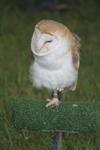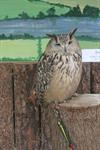Owls
 What Type of Owl is that?
What Type of Owl is that?
Owls are nocturnal birds of prey, belonging to the order Strigiformes. They all have distinctive calls: either hoots, whistles or shrieks, and are most vocal just after dusk, or just before dawn. Owls fly silently. All other birds are noisy when flying, with noises being produced by the leading edges of the wings as they cut through the air. Owls who depend on stealth when hunting, avoid the wing noises by special adaptations to the leading feathers on the wings. The individual filaments of these feathers lack alternate bards, and are loosely held together. The structure of the feathers is such that the air can filter through them as opposed to being divided by the wings, as happens in other birds.
They are divided into two sub families:
1. Strigidae (Typical Owls) - These conform to the basic owl pattern. There are 139 species here.
2. Tytonidae (Barn Owls) - There are 12 species in this group.
Owl Distribution
Owls occur on every continent except Antarctica.
Owl Structure
Owls are externally distinguished by their big heads, and radiated puffs of feathers around the large eyes. They have loose plumage that makes them look much larger than they really are. Owls have four toes, each armed with a long hooked talon. These birds can change the shape of their feet. They can use the standard three toes forward and one backward shape when they are hunting; or they can swivel the outer two backwards to give a two-toe layout used for perching. Owls also have a sharply hooked beak.
Owl Hunting and Feeding
 Owls hunt mainly at dusk, or throughout the night. Their senses are attuned to finding prey in very poor light conditions, and their ears are exceptionally sensitive being able to pick up the sounds of a scurrying rodent when it is some distance away. The silent flight is very important in this aspect, because any loud flapping would interfere with the direction finding ability of the ears.
Owls hunt mainly at dusk, or throughout the night. Their senses are attuned to finding prey in very poor light conditions, and their ears are exceptionally sensitive being able to pick up the sounds of a scurrying rodent when it is some distance away. The silent flight is very important in this aspect, because any loud flapping would interfere with the direction finding ability of the ears.
For some owls, sight is very important. Owls have a sense of sight adapted to finding prey with an accuracy that allows one swoop to stand a very high chance of success. The eyes face forward, giving near perfect binary vision. With the two eyes focused on an object simultaneously, the distance to the object is determined with great accuracy. However, the fact that the eyes face forward means that that there is a large blind spot behind the owl. To overcome this, owls can twist their heads through 180 degrees, and in doing so, they can inspect their surroundings without moving their body.
Hunting small mammals, usually rodents, is normal for owls. These rodents are captured and killed before being carried off to the perch. Once at the perch, the prey is swallowed whole if small enough, otherwise it is torn apart by the owl’s hooked bill. The bird then remains in a roosting position, digesting all soft tissue and regurgitating bones, feathers, fur and any other indigestible material as pellets. Pellets are formed in an owl’s gizzard, where the hard remains become trapped. The gizzard compresses them into a smooth shape to allow for easy regurgitation. Owls are a great benefit to farmers because they can help control vermin.
The Barn Owl (Tyto alba)
Belonging to the Tytonidae, this is very widespread, occurring in most parts of the world, except some isolated islands. The plumage is tawny yellow above, with a white face and white under parts. It is a medium sized owl with a length of approximately 33 cm. It nests in hollow trees (like most owls). The nest consists of some vomited material (The nest is not conventional). The female lays a clutch of about five eggs, and she sits on the eggs being fed by the male until the young hatch. After the eggs hatch, both the male and female hunt for food. In its nocturnal hunting, this bird can wander great distances. Its call is a strident and discordant scream, which has earned it the alternative name "screech owl".
Frogmouths
Frogmouths are small or large nocturnal birds which resemble owls in appearance but belong to a different family (Podargidae). The frogmouths are a group of nocturnal birds related to the nightjars. They are found from <st1:country-region>India</st1:country-region> across southern Asia to <st1:country-region>Australia</st1:country-region>. They are named for their large flattened hooked bills and huge frog-like gape, which they use to take insects. Their flight is weak. They rest horizontally on branches during the day, camouflaged by their cryptic plumage. Up to three white eggs are laid in the fork of a branch, and are incubated by the female at night and the male in the day.
Tawny Frogmouth (Podargus strigoides)
Marbled Frogmouth (Podargus ocellatus)
Papuan Frogmouth (Podargus papuensis)
Large Frogmouth (Batrachostomus auritus)
[02/01/2026 02:19:54]